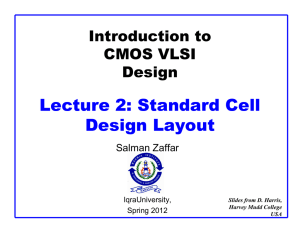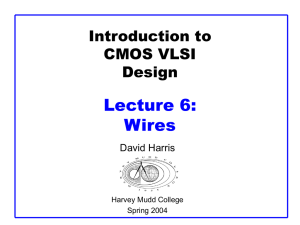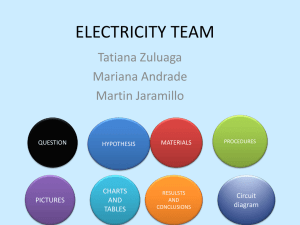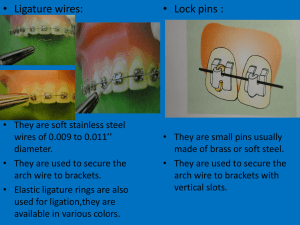Lecture 14: Wires
advertisement
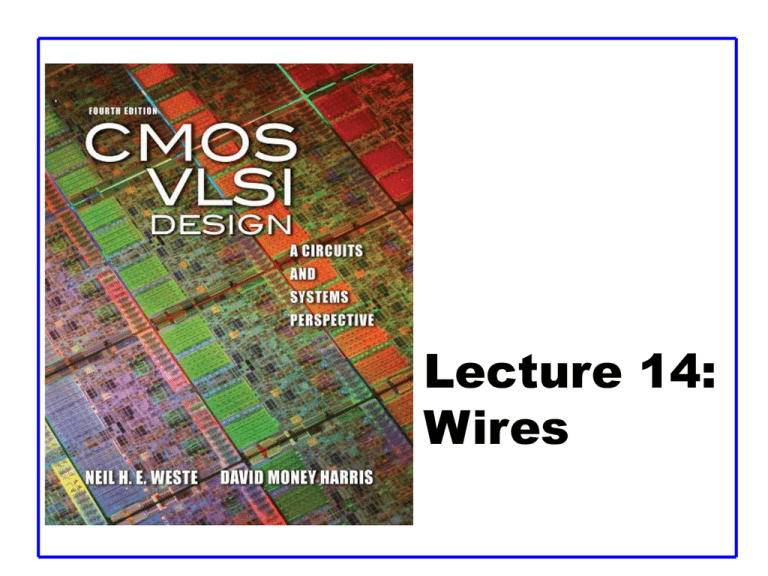
Lecture 14: Wires Outline Introduction Interconnect Modeling – Wire Resistance – Wire Capacitance Wire RC Delay Crosstalk Wire Engineering Repeaters 14: Wires CMOS VLSI Design 4th Ed. 2 Introduction Chips are mostly made of wires called interconnect – In stick diagram, wires set size – Transistors are little things under the wires – Many layers of wires Wires are as important as transistors – Speed – Power – Noise Alternating layers run orthogonally 14: Wires CMOS VLSI Design 4th Ed. 3 Wire Geometry Pitch = w + s Aspect ratio: AR = t/w – Old processes had AR << 1 – Modern processes have AR 2 • Pack in many skinny wires w s l t h 14: Wires CMOS VLSI Design 4th Ed. 4 Layer Stack AMI 0.6 mm process has 3 metal layers – M1 for within-cell routing – M2 for vertical routing between cells – M3 for horizontal routing between cells Modern processes use 6-10+ metal layers – M1: thin, narrow (< 3l) • High density cells – Mid layers • Thicker and wider, (density vs. speed) – Top layers: thickest • For VDD, GND, clk 14: Wires CMOS VLSI Design 4th Ed. 5 Example Intel 90 nm Stack Intel 45 nm Stack [Thompson02] 14: Wires [Moon08] CMOS VLSI Design 4th Ed. 6 Interconnect Modeling Current in a wire is analogous to current in a pipe – Resistance: narrow size impedes flow – Capacitance: trough under the leaky pipe must fill first – Inductance: paddle wheel inertia opposes changes in flow rate • Negligible for most wires 14: Wires CMOS VLSI Design 4th Ed. 7 Lumped Element Models Wires are a distributed system – Approximate with lumped element models N segments R R/N C R/N C/N C/N R R C L-model C/2 R/N R/N C/N C/N R/2 R/2 C/2 p-model C T-model 3-segment p-model is accurate to 3% in simulation L-model needs 100 segments for same accuracy! Use single segment p-model for Elmore delay 14: Wires CMOS VLSI Design 4th Ed. 8 Wire Resistance r = resistivity (W*m) r l l R R t w w R = sheet resistance (W/) – is a dimensionless unit(!) Count number of squares – R = R * (# of squares) w l w l t l t 1 Rectangular Block R = R (L/W) W 14: Wires w CMOS VLSI Design 4th Ed. 4 Rectangular Blocks R = R (2L/2W) W = R (L/W) W 9 Choice of Metals Until 180 nm generation, most wires were aluminum Contemporary processes normally use copper – Cu atoms diffuse into silicon and damage FETs – Must be surrounded by a diffusion barrier Metal Bulk resistivity (mW • cm) Silver (Ag) 1.6 Copper (Cu) 1.7 Gold (Au) 2.2 Aluminum (Al) 2.8 Tungsten (W) 5.3 Titanium (Ti) 43.0 14: Wires CMOS VLSI Design 4th Ed. 10 Contacts Resistance Contacts and vias also have 2-20 W Use many contacts for lower R – Many small contacts for current crowding around periphery 14: Wires CMOS VLSI Design 4th Ed. 11 Copper Issues Copper wires diffusion barrier has high resistance Copper is also prone to dishing during polishing Effective resistance is higher r l R t tdish tbarrier w 2tbarrier 14: Wires CMOS VLSI Design 4th Ed. 12 Example Compute the sheet resistance of a 0.22 mm thick Cu wire in a 65 nm process. Ignore dishing. 2.2 108 Ω m R 0.10 W / 6 0.22 10 m Find the total resistance if the wire is 0.125 mm wide and 1 mm long. Ignore the barrier layer. 1000 m m R 0.10 Ω/ 800 W 0.125 m m 14: Wires CMOS VLSI Design 4th Ed. 13 Wire Capacitance Wire has capacitance per unit length – To neighbors – To layers above and below Ctotal = Ctop + Cbot + 2Cadj s w layer n+1 h2 Ctop t h1 layer n Cbot Cadj layer n-1 14: Wires CMOS VLSI Design 4th Ed. 14 Capacitance Trends Parallel plate equation: C = eoxA/d – Wires are not parallel plates, but obey trends – Increasing area (W, t) increases capacitance – Increasing distance (s, h) decreases capacitance Dielectric constant – eox = ke0 • e0 = 8.85 x 10-14 F/cm • k = 3.9 for SiO2 Processes are starting to use low-k dielectrics – k 3 (or less) as dielectrics use air pockets 14: Wires CMOS VLSI Design 4th Ed. 15 Capacitance Formula Capacitance of a line without neighbors can be approximated as 0.25 0.5 w w t Ctot e ox l 0.77 1.06 1.06 h h h This empirical formula is accurate to 6% for AR < 3.3 14: Wires CMOS VLSI Design 4th Ed. 16 M2 Capacitance Data Typical dense wires have ~ 0.2 fF/mm – Compare to 1-2 fF/mm for gate capacitance 400 350 300 M1, M3 planes s = 320 s = 480 s = 640 s= 200 8 Ctotal (aF/mm) 250 Isolated s = 320 150 s = 480 s= 8 s = 640 100 50 0 0 500 1000 1500 2000 w (nm) 14: Wires CMOS VLSI Design 4th Ed. 17 Diffusion & Polysilicon Diffusion capacitance is very high (1-2 fF/mm) – Comparable to gate capacitance – Diffusion also has high resistance – Avoid using diffusion runners for wires! Polysilicon has lower C but high R – Use for transistor gates – Occasionally for very short wires between gates 14: Wires CMOS VLSI Design 4th Ed. 18 Wire RC Delay Estimate the delay of a 10x inverter driving a 2x inverter at the end of the 1 mm wire. Assume wire capacitance is 0.2 fF/mm and that a unit-sized inverter has R = 10 KW and C = 0.1 fF. – tpd = (1000 W)(100 fF) + (1000 + 800 W)(100 + 0.6 fF) = 281 ps 14: Wires CMOS VLSI Design 4th Ed. 19 Wire Energy Estimate the energy per unit length to send a bit of information (one rising and one falling transition) in a CMOS process. E = (0.2 pF/mm)(1.0 V)2 14: Wires = 0.2 pJ/bit/mm = 0.2 mW/Gbps CMOS VLSI Design 4th Ed. 20 Crosstalk A capacitor does not like to change its voltage instantaneously. A wire has high capacitance to its neighbor. – When the neighbor switches from 1-> 0 or 0->1, the wire tends to switch too. – Called capacitive coupling or crosstalk. Crosstalk effects – Noise on nonswitching wires – Increased delay on switching wires 14: Wires CMOS VLSI Design 4th Ed. 21 Crosstalk Delay Assume layers above and below on average are quiet – Second terminal of capacitor can be ignored – Model as Cgnd = Ctop + Cbot Effective Cadj depends on behavior of neighbors A B – Miller effect C Cgnd B DV Ceff(A) MCF Constant VDD Cgnd + Cadj 1 Switching with A 0 Cgnd 0 Switching opposite A 2VDD Cgnd + 2 Cadj 2 14: Wires CMOS VLSI Design 4th Ed. adj Cgnd 22 Crosstalk Noise Crosstalk causes noise on nonswitching wires If victim is floating: – model as capacitive voltage divider DVvictim Cadj Cgnd v Cadj DVaggressor Aggressor DVaggressor Cadj Victim Cgnd-v 14: Wires DVvictim CMOS VLSI Design 4th Ed. 23 Driven Victims Usually victim is driven by a gate that fights noise – Noise depends on relative resistances – Victim driver is in linear region, agg. in saturation – If sizes are same, Raggressor = 2-4 x Rvictim DVvictim Cadj 1 DVaggressor Cgnd v Cadj 1 k Raggressor 14: Wires Cgnd-a DVaggressor aggressor Raggressor Cgnd a Cadj k victim Rvictim Cgnd v Cadj CMOS VLSI Design 4th Ed. Aggressor Cadj Rvictim Victim Cgnd-v DVvictim 24 Coupling Waveforms Simulated coupling for Cadj = Cvictim 14: Wires CMOS VLSI Design 4th Ed. 25 Noise Implications So what if we have noise? If the noise is less than the noise margin, nothing happens Static CMOS logic will eventually settle to correct output even if disturbed by large noise spikes – But glitches cause extra delay – Also cause extra power from false transitions Dynamic logic never recovers from glitches Memories and other sensitive circuits also can produce the wrong answer 14: Wires CMOS VLSI Design 4th Ed. 26 Wire Engineering Goal: achieve delay, area, power goals with acceptable noise Degrees of freedom: – Width – Spacing – Layer – Shielding 0.8 1.8 0.7 Coupling:2Cadj / (2C adj+Cgnd) 2.0 1.6 Delay (ns):RC/2 1.4 1.2 1.0 0.8 0.6 0.4 0.2 0 0.6 0.4 0.3 0.2 0.1 0 0 500 1000 1500 0 2000 1000 500 14: Wires a1 gnd a2 a3 vdd vdd a0 gnd a1 vdd a2 gnd 1500 2000 Pitch (nm) Pitch (nm) vdd a0 WireSpacing (nm) 320 480 640 0.5 a0 b0 a1 CMOS VLSI Design 4th Ed. b1 a2 b2 27 Repeaters R and C are proportional to l RC delay is proportional to l2 – Unacceptably great for long wires Break long wires into N shorter segments – Drive each one with an inverter or buffer Wire Length: l Driver Receiver N Segments Segment l/N Driver 14: Wires l/N Repeater l/N Repeater Repeater Receiver CMOS VLSI Design 4th Ed. 28 Repeater Design How many repeaters should we use? How large should each one be? Equivalent Circuit – Wire length l/N • Wire Capacitance Cw*l/N, Resistance Rw*l/N – Inverter width W (nMOS = W, pMOS = 2W) • Gate Capacitance C’*W, Resistance R/W RwlN R/W 14: Wires Cwl/2N Cwl/2N C'W CMOS VLSI Design 4th Ed. 29 Repeater Results Write equation for Elmore Delay – Differentiate with respect to W and N – Set equal to 0, solve l 2 RC N RwCw t pd 2 2 l W 14: Wires RC RwCw ~40 ps/mm in 65 nm process RC w Rw C CMOS VLSI Design 4th Ed. 30 Repeater Energy Energy / length ≈ 1.87CwVDD2 – 87% premium over unrepeated wires – The extra power is consumed in the large repeaters If the repeaters are downsized for minimum EDP: – Energy premium is only 30% – Delay increases by 14% from min delay 14: Wires CMOS VLSI Design 4th Ed. 31
